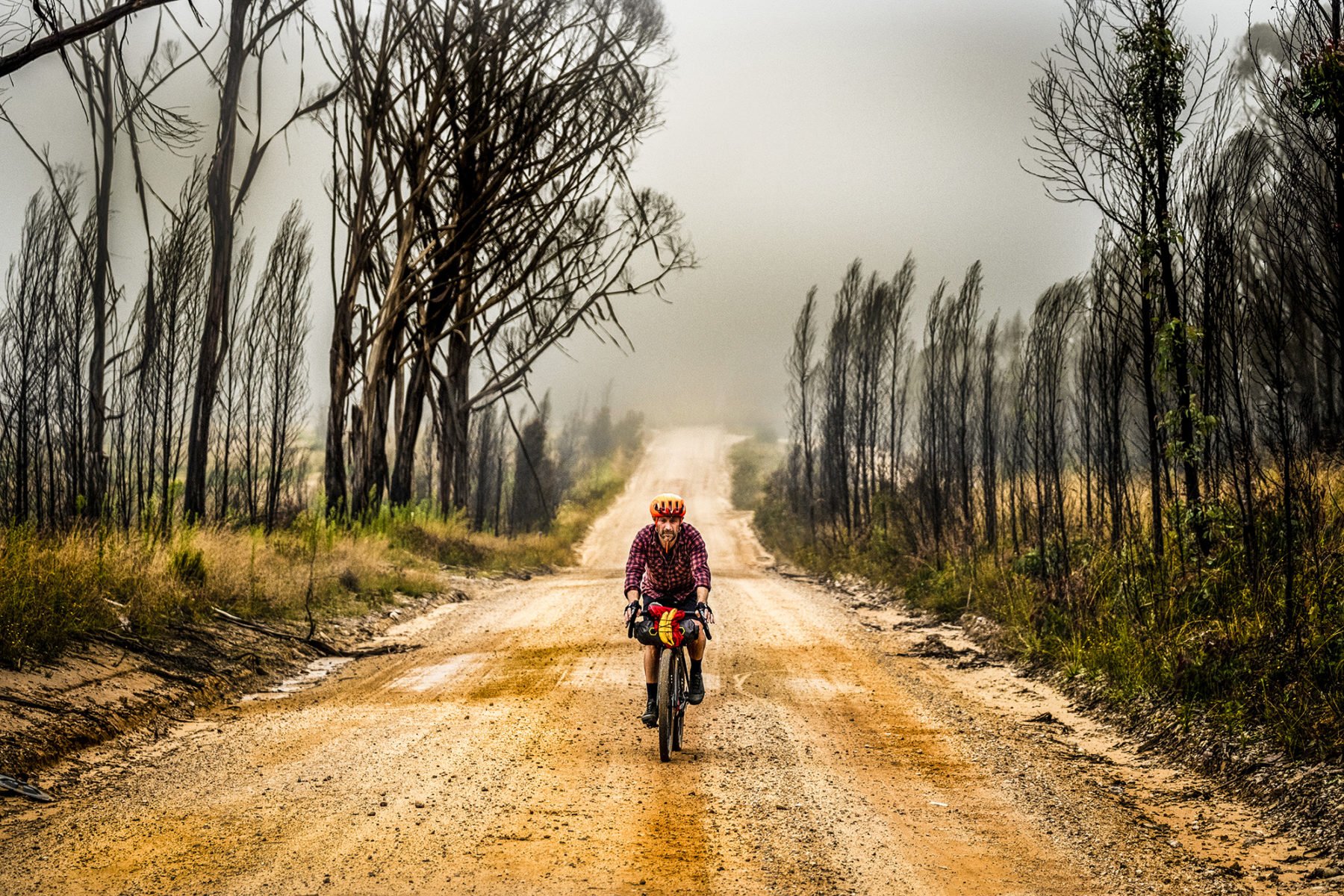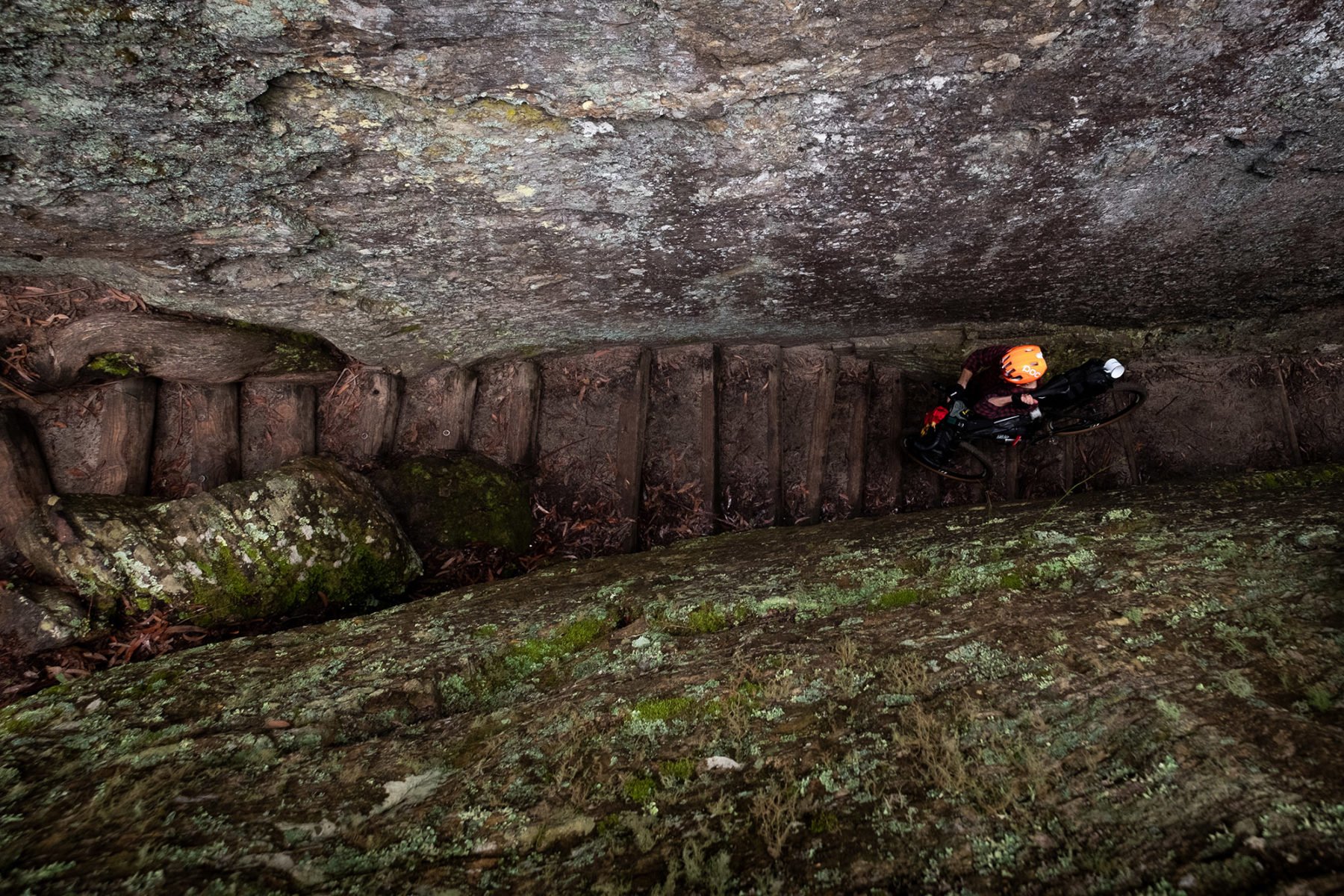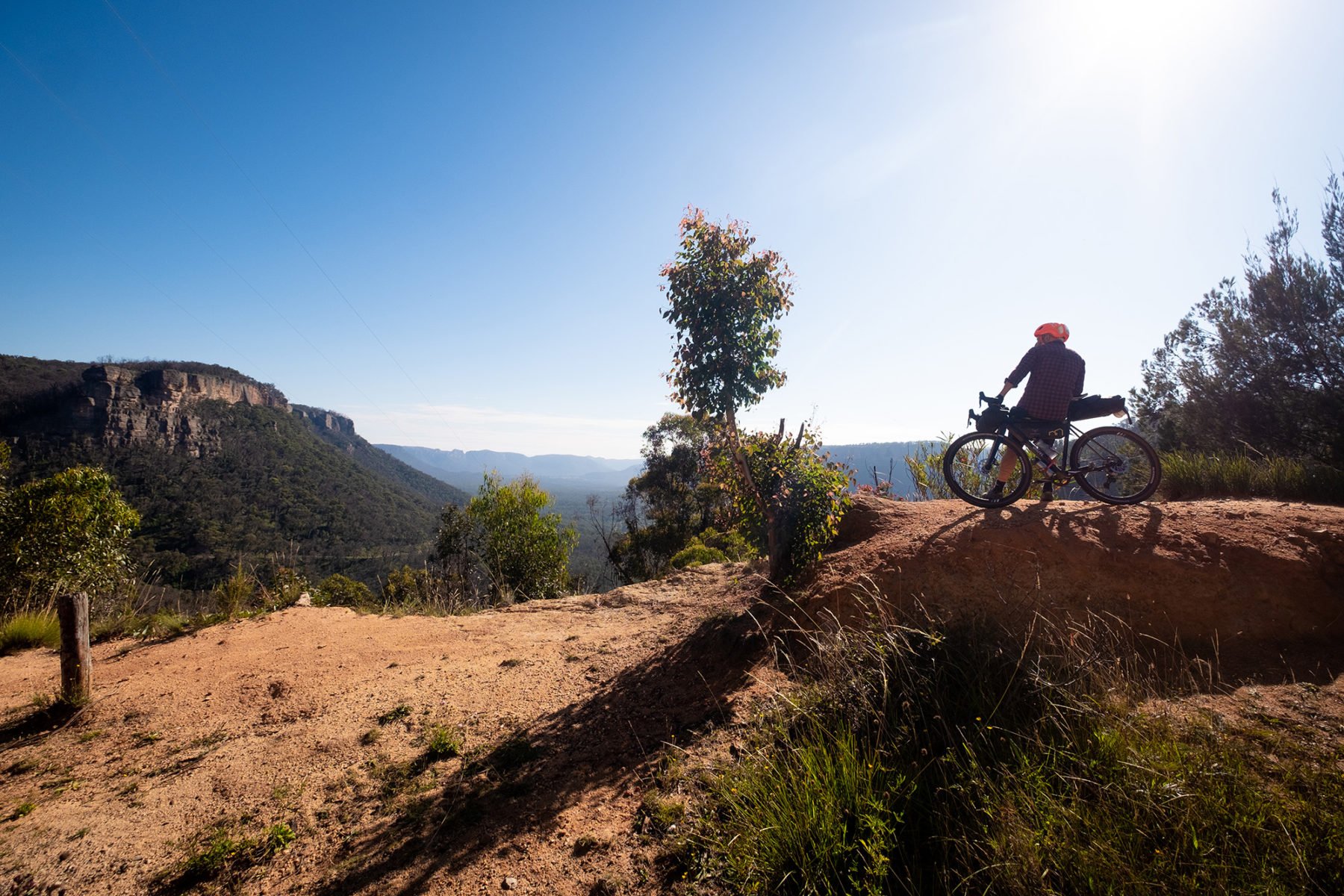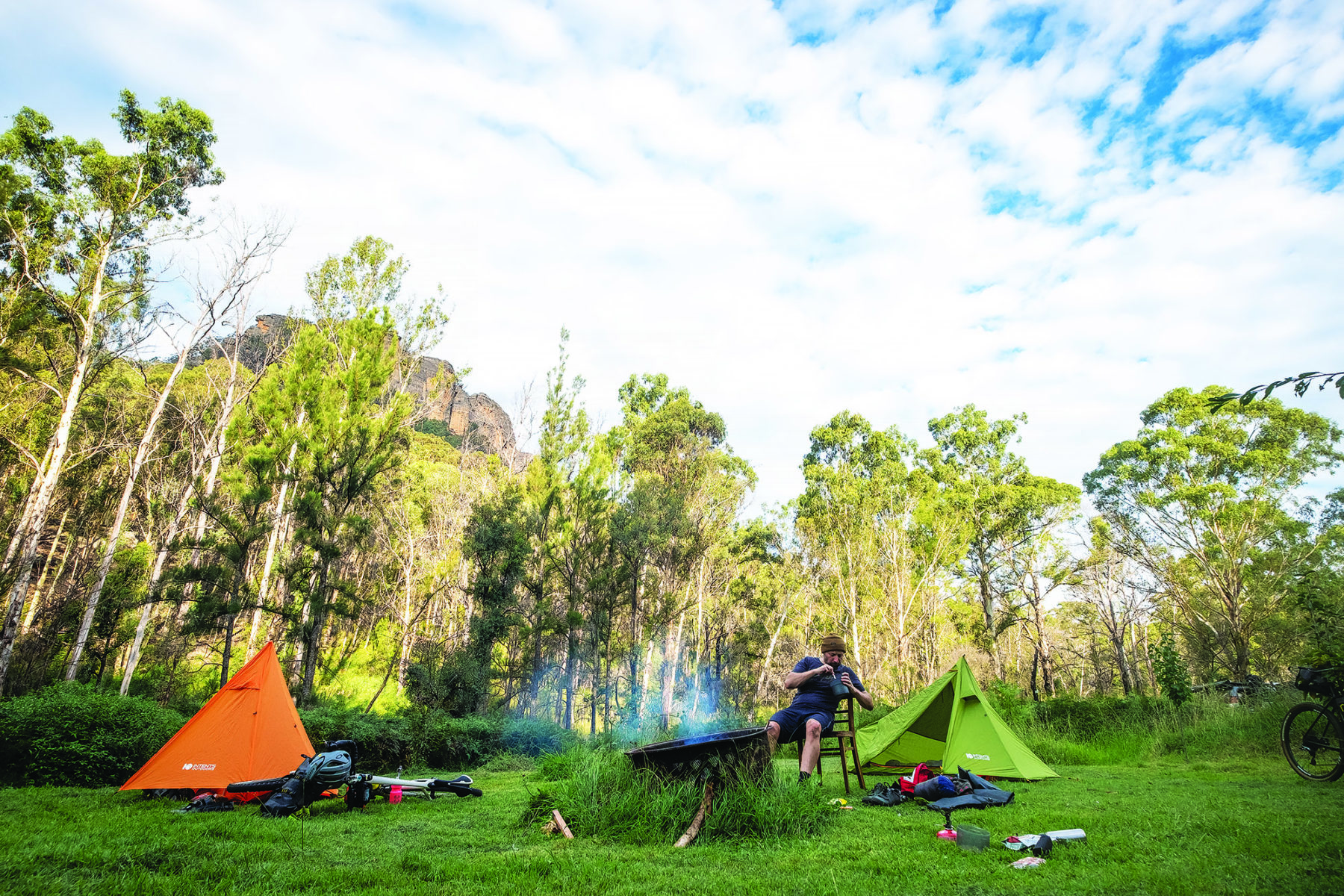Through the hall of the mountain king: cycling Lithgow to Newnes, NSW

The western side of the Blue Mountains seems a world away from inner Sydney. But, in fact, it is not only closer than you think, but is the location of one of the staple short bikepacking trips out of Sydney: the Lithgow to Newnes loop. Within driving distance from the centre of town and covering just over 100km over two days – roughly 50kays out; 50 kays back – it sounded simple when I suggested it to Aus Geo ADVENTURE’s gravel bike-riding former Creative Director, Mike Ellott. As we know, though, ‘simple’ is never around when you’re planning an epic bike-borne adventure…
In the beginning
For the week leading up to this ride, the weather forecast had been persistent. And when I say persistent, I mean persistently rubbish. I called Mike two days out hoping he would make the call to postpone, as I didn’t want to be the party-pooper myself. But Mike, ever positive, said it would just make for better images and a better story if we had to suffer through the weather. I reluctantly agreed.
This saw us leaving Sydney bright and early for the two and a half-hour drive through ominous clouds and rain towards Lithgow on a Saturday morning, aiming to be on the bikes around 8:30am. That, folks, is when the fun really began.
Towards the tunnels
Once we reach Lithgow, it’s go-time. We pack the bikes, make a quick phone call to our partners before hitting the road and losing reception as we enter the mountains.
The legs are barely warm, and we’ve only covered a few kilometres of cycling on back roads of Lithgow, before the road turns to gravel and we go up. I can see the treetops are covered in fog as we settle into the very steep climb and Mike leaves me to find my own rhythm (or drops me, however you want to put it).

This isn’t the first time I’ve ridden this bike with a bit of weight onboard and cursed my gearing. I swear I’ll sort something out for next time.
Once we summit, we’re well and truly into the fog and cycle along wide, smooth-gravel fire-trails, maintaining a decent pace thanks to our fresh legs. We traverse a landscape that varies from some open logging grounds to tall fire-damaged woodlands, before being surrounded by lush greenery.
The bright green regrowth on the charred black columns of the tree stumps really stand out against the backdrop of the fog. It’s amazing to see nature recover as it does, but also a pretty severe reminder of how bad the fires were to see such an altered landscape more than a year later.
We start seeing signs for the area’s famous ‘glow worm tunnels’, which builds a little excitement as this is what this ride is all about. The tunnels aren’t just a landmark to see along the way; we have to pass through over 500m of tunnels, to continue on our way to Newnes.
We’ve seen a few four-wheel drives by this stage but the roads are really quiet, and we start dropping downhill toward the trailhead. The road winds down through huge carved rock faces, with huge ferns shadowing us at the edges of the dirt road we follow.
This is the point the terrain changes, and it’s the last we’ll see of smooth gravel roads today. The track becomes rocky and narrow; some of my bags rattle off my bike and require refitting.
Soon after, the track seems to come to an end; we dismount and walk down some stairs with our bikes to a small footbridge that seems to go nowhere. As we cross, it appears to aim directly at a large rock wall.

We discover the walkway turns left through a small cleft with a narrow, steep, stone staircase climbing out of the gully. It’s quite narrow to walk through, never mind trying to lug an awkward and heavy bike through. A few groans, complaints and grazed knuckles later, we’re through. These stairs are the last hurdle before the long-awaited tunnels.
Cycling through the darkness
The entrance to the tunnel is a black hole in a ring of greenery and giant prehistoric ferns, and a trickle of water streaming down the rocks on the side and into the tunnel itself. I, unfortunately, forgot I would be needing my head torch halfway through the day and packed it with all my camping gear, so I had to unpack my entire front roll and re-pack before we ventured in. We also used the opportunity to grab a little bit of lunch while I had everything out.
It doesn’t take long before it’s pitch black and we’re relying on our torches to illuminate our path. The surface is very rough and certainly not rideable. The water flowing through becomes a little more substantial and requires some careful tiptoeing around to keep your feet dry.
About 100m into the abyss Mike spots an Australian red claw crayfish (Cherax quadricarinatus I think). I didn’t think we would find anything like it in here, so it was definitely a nice surprise. I managed to pick it up without losing a finger for a closer look.
We stop at what we guess is halfway so we can turn our torches off and look for the famous glow worms. As soon as our torches are off we can see hundreds of tiny green specs all over the walls, and literally nothing else. I think it may have been around this point that Mike’s sunglasses decided to leave us; we went in with them and came out without them.

When we emerge from the darkness on the other side, there is a stunning trail that crosses a little creek a few times as we make our way out of the rock formations. This section requires a little time off the bike, having to jump over the creek and up and over some boulders here and there, so it’s slow going.
Once we leave the crevasse we’re back in the sun on the side of the mountain with a smoother trail, only to come an obstacle every time we manage to crack a bit of pace. Some of it is rideable, with a few nifty bike skills, some are fallen trees, others are massive rock slides that require lifting our bikes up and down to one another before moving on. We’re definitely not winning any land-speed records here. It’s also at this point that I realise rigid carbon-soled clip-in cycling shoes are not ideal for rock climbing…
We come to the end of that trail and have to pass through a gate with a sign identifying the trail to Newnes that, excitingly, signals the final stretch. Well, maybe…
Here for a moment, we get some speed, enjoy the wind on our faces, before the trail seems to disappear again. It seems to have fallen away and there is only a vertical drop to rubble below. We backtrack a little before finding the overgrown route around the fallen track. Then, it’s off the bikes again and up the other – very steep – side.. And I don’t mean steep to ride – I mean it’s more of an actual climb on rocks with your arms and hands, while manhandling your bike as well. It’s at this point I ask Mike how he’s going? And get the expected – “I want to RIDE my bike!” – answer.
After a little more hike-a-bike we’re onto a nice grassy trail. The smell of summer, fresh new sprouts and flower buds only enhance the wonderful free feeling of fulfilling Mike’s wishes and actually riding our bikes.
It’s the last 10km or so – winding smooth trail, the odd creek crossing or fallen tree – but smooth sailing, with the river our left, into Newnes. And then we spot a most welcome sight: the Newnes Hotel, on the other side of the river.
We take our shoes off and wade across, gently rolling onto the lawn of the hotel.
Newnes
The Newnes Hotel is a remarkable place, built-in 1907 amongst the spectacular sheer cliff faces of the Wolgan Valley, the hotel is the only remaining building of the former mining town of Newnes.
Unfortunately, for this pair of trail-weary travellers, the bar no longer serves beers, or even hot meals. The hotel is, in fact, a living museum, dedicated to the history of the area and the hotel itself. The owners Thomas and Helen Ebersole opened their first cabin here in 2004 after discovering the Wolgan Valley on a camping trip and have opened several more cabins over the years since. The museum is effectively a time capsule, seemingly not updated for a few decades – and in need of a bit of dusting – but this only adds to the character. The front bar seems just as it was, with plenty of old bottles and antiques, posters and even the old piano. Plus, there’s a bloody nice view.
The cliffs surrounding the hotel catch the afternoon light, while the rest of the valley is in shade, they come alive with a fluorescent orange glow and make for a magnificent backdrop to set up camp.

Today’s ride is enough to get the legs going, and the arms, but not too big to have to rush to make camp. We arrive mid-afternoon and take our time setting up camp. There’s no reception here and we just make the most of not having any phones to distract or bother us for a few hours; instead, just sitting and soaking up the serenity.
Misty mornings and big climbs
I wake to Mike calling out, “Oi Bob”.
I’ve slept in. I assure him this is highly unusual for me, but he knows not to believe me. Mike’s half-packed his Grove R.A.D. (see our review of this Aussie gravel bike here) by the time I’m out of the tent…
Today we’re looking at a day of riding and only riding. Just one major hurdle as far as we can tell from the profile: a 6km climb, half of which is on tarmac. It looks easy.
The valley is covered completely in mist. We head out the same direction we came in, but on the other side of the river, via a gravel road. This road hasn’t been graded in some time, and the corrugations are relentless. No line is smooth; we’re both moving from left to right, in the middle, in between, and still no smoothness can be found. I have a feeling that we were missing some beautiful countryside because of the fog as well. This is turning into a red mist.
When we hit the tarmac, things pick up a little until we get to the foot of the climb. We know we are there thanks to the oversized sign that says, “Very steep climb next 3km”. This is only the first half, though, and we grind it out to the top of the road and take a moment to take in the landscape looking back over the mountains and over the road and climb we’ve just conquered.
At Blackfellows Hand Trail we make a left and start the dirt part of the climb. The sun is just cracking over the top of the rocky outcrops, and the conversation is nil at this point. I’m struggling, and Mike has again left me to ride to my own rhythm.
If nothing, this leisurely pace gives us the chance to check out some intriguing rock formations in the early part of the dirt climb, but we eventually hit the top and we find ourselves back on smooth gravel fire trails across a ridgeline heading back towards Lithgow.
We meet the road we rode yesterday, for the final run into town, and have the pleasure of descending the climb we battled up yesterday. This relatively short day in the saddle also means we have the perfect excuse to indulge in lunch at the Lithgow Tin Shed and celebrate the accomplishment of this awesome mini-epic. The Tin Shed itself provides a further excuse to simply take our time over lunch, before resigning ourselves to the return journey back to the hustle and bustle of Sydney.
Bikepacking reflections
This two-day ride isn’t for the faint of heart. Despite wrapping up both days relatively early, it was a good hustle on the bikes to complete it. If you’re considering it, be ready to hike-a-bike for a few hours on the first day. It helps if you know that’s coming, and it’s not actually so bad once it is finished.
This is the second time I’ve tackled this route, each time bringing a Glow Worm first-timer along with me. It’s a brilliant route to test your legs and set-up for some rough terrain if you ever plan on going long and off the beaten track.





